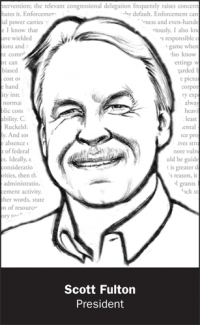Sustainable development — the buzzword for humanitarian aid organizations, assistance agencies, academics, and conservation groups — is facing an identity crisis. The term was introduced into the mainstream in the 1987 Brundtland Commission report. It famously urges intergenerational equity as a guiding principle for economic development. Adding environmental and social supports to the traditional economic leg of the development stool, the commission argues that advancement based on all three legs will not only provide long-term stability but will in effect raise the height of the seat. To improve humanity’s lot on a bountiful planet, the challenge, then, of sustainable development involves reconciling seemingly contrary goals, of ensuring that each leg truly supports the stool.
The 2015 Sustainable Development Goals capture our current rendition of the concept. An update themselves to the Millennium Development Goals, which were established in 2000 as a tool for focusing international attention on less-advanced countries, the 17 SDGs are more comprehensive and offer a decisionmaking framework that applies to all countries, rich and poor. Critics are quick to note that the SDGs are in no way legally binding. They aren’t a treaty. Indeed, the UN-brokered SDGs don’t compel countries to do anything at all. They are voluntary, with aspirational targets such as “no poverty” and “gender equality.”
No single goal can be seen to be more or less important than the others, and in the absence of an admittedly impossible prioritization scheme, sustainable development effectively can mean all things to all people.
Further confounding the operationalization of the SDGs is climate change. While the SDGs include “climate action” as one of the 17 goals, in fact today we understand the concept of sustainable development almost entirely within the context of a warming planet. As the complex dynamics of development in a carbon-constrained world have emerged, the very notion of whether it is possible to have sustainable development is at stake.
But perhaps there is no other time in recent history that better reminds us how important statements of shared priorities can be. They may lack legal force, but the SDGs represent nothing less than agreed-upon principles for human advancement. They help focus broad efforts that are invariably under-resourced by offering touchstones to guide trade-offs. And they provide a mechanism for flagging actions that don’t meet the standards. Countries with wildly different approaches to economic development and politics now routinely integrate language from the SDGs to align their efforts with global norms.
But to be useful on the ground, the SDGs must be subject to place-based analysis. Without field-testing, we might value the shared set of concepts but cannot assess whether in fact the goals are actionable and achievable. The discovery of a massive natural gas deposit off the coast of Mozambique presents a compelling case study. As part of an inter-disciplinary team of students and researchers from Columbia University’s Earth Institute, I had the opportunity to visit the country in 2018.
The Republic of Mozambique is a former Portuguese colony located along Africa’s southern Indian Ocean coastline, across from the island of Madagascar. The country achieved independence in 1975, and 16 years of civil war followed. Reconstruction efforts ushered in a period of rapid growth, both economically and politically. The new constitution, established in 1990, created democratic political structures, and subsequent amendments emphasized a decentralized system, with local elected provincial assemblies. Perhaps as a consequence of this recent political upheaval, institutional development has lagged. The Ministry of Land, Environment and Rural Development was created only five years ago.
Most Mozambicans rely on rain-fed subsistence agriculture for survival, with an estimated 25 percent of GDP coming from that sector. International donors have largely funded the country’s economic growth; one outcome of this support is high levels of national debt. While natural resources are abundant, with more than a thousand miles of coastline supporting fishing and trade, poverty remains the persistent reality for more than half of the citizenry. Fully 70 percent of the country’s 29 million residents live in rural conditions, with an estimated literacy rate of 58 percent nationwide. Women and those who live far from the capital city of Maputo are especially unlikely to have any formal education beyond primary school. Health care is similarly scarce. The country ranks among the poorest in the world.
In 2014, geologists discovered 85 trillion cubic feet of natural gas in the Rovuma Basin off the coast of northern Mozambique. In addition, there are known oil deposits that include the Pande and Temane fields, with exploration that began during colonial times and has continued in earnest since independence. The new gas discovery has sparked international interest; Anadarko is now leading a consortium of global energy companies in exploring and developing the vast deposit. Plans include extraction, onshore processing, and an industrial mega-zone located in the remote far northern region of the country.
The company has drafted a lengthy and detailed environmental impact assessment, but questions remain. Among the most pressing is whether the public will benefit from the discovery of such valuable resources along their country’s coastline. If new energy resources can be a trigger for improved livelihoods and a more resilient national development pathway, then we might see progress toward the SDGs. But historical evidence cautions that when an impoverished country is the site of abundant petroleum, the opposite happens.
Decades of study on the resource curse has yielded some consistent results that planners in Mozambique would do well to remember as they chart a different path. In the short term, a sudden spike in mineral wealth can trigger violence. Civil conflict frequently persists when such wealth is concentrated in the hands of elites at the expense of workers. Ongoing violence in Sierra Leone has accompanied the profitable diamond trade there. Nigeria’s oil abundance is similarly paired with persistent militant activity. Not coincidentally, prominent and bloody incidents of terrorism in the northern region of Mozambique have accompanied the early stages of infrastructure for natural gas development in the country.
Over the longer term, researchers find a strong correlation between mineral wealth and a decline in democracy. Revenue from extractive industries tends to support incumbent leaders, and that can be a stabilizing force. However, in countries with fragile governments, resource wealth often erodes democratic institutions and leads to autocratic rule. Today, 23 countries generate more than 60 percent of their exports in the form of oil and gas; none of these are stable democracies. Wealthy nations like the United Arab Emirates have clearly benefitted from their reliance on minerals, but the growth strategy that stems from oil abundance has rendered democracy a non-starter. Newer democracies and countries with high corruption profiles fare especially poorly. Sub-Saharan Africa in particular has been a veritable showcase for the resource curse, as recently independent countries find themselves ill-equipped to juggle the myriad indirect impacts associated with resource wealth.
Mineral abundance also correlates with declining performance on a range of indices that track human development and sustainability. Sudan, the Democratic Republic of the Congo, and Gabon are just a few of the most well-known examples. In each of those cases, the country is a major exporter of valuable minerals, and all rank high in corruption and low in literacy, health care, education, and lifespan.
How can Mozambique do better? The resource curse is not a monolith, and policymakers have learned some valuable lessons over time. Still, easy solutions don’t exist. Despite the extensive literature on the causes and outcomes of the curse, very little attention has been devoted to solutions. Without identifying the resource curse explicitly, the SDGs provide potential guidance. Most directly, SDG #7 identifies affordable and clean energy as key. Indirectly, several other goals form a nexus with the challenges facing Mozambique. For example, SDG #9 urges innovation and industrial growth; SDG #11 seeks sustainable communities; and SDG #14 focuses on life below water, clearly a matter of concern for off-shore energy development and fisheries.
Within the scientific literature generally and the SDGs explicitly, one place of agreement is that institutions are key. Resource-rich democracies provide a useful guidepost. In Norway, for example, a stable system has fostered a durable institutional structure. No resource curse has befallen the oil-soaked European nation; to the contrary, Norwegians enjoy some of the highest incomes in the world. Citizens are among the happiest on Earth.
As the foundation of a legal and policy framework, institutions need to reflect national values like an intolerance for corruption, support for the rule of law, and a priority for capacity building. Civil society — already weak in Mozambique, as in many newly democratic states — should find safe avenues for participation. Local governments are especially critical for community services when a national government is captured by industrial triumphalism; they should be empowered. Since steady revenue from minerals tends to insulate national governments from accountability — especially when it eliminates the need to tax residents — Mozambique will need to be particularly attentive to opportunities that can expand the authority held by local administrators.
Some research suggests that strong property rights can help to fortify residents against the negative effects of industrial dominance. Mozambique’s Land Law, passed in 1997, retained ownership of all land in the hands of the national government. Residents are granted use rights, and notably the law explicitly recognizes customary rights. While this provision is a victory for indigenous groups, who may hold land for generations without legal title, it is likely to be insufficient in the face of nationally backed industrial mandates for expansion. The vast majority of small-holders in the country still lack formal title to their land.
While property rights and strong institutions can meaningfully contribute to sustainable development, most of the solutions to the resource curse can be found in transparency. With an eye toward improved accountability, the argument for transparency suggests that government watchdogs and civil society can provide an essential check on centralized power only if governments and the private sector are forced to showcase their actions. Today, many transnational companies acknowledge the importance of transparent operations; in this instance, Anadarko has already completed the massive environmental assessment and made it publicly available. But still the challenges are deep, complex, and inextricable from the promise of new mineral wealth.
For example, how much of the new energy resource should remain in domestic hands rather than be exported? Can an influx of natural gas improve energy availability in a rural country with a nearly non-existent power grid outside of its urban cores? Some have argued that a more sustainable approach to energy development might mean leap-frogging a traditional grid designed for fossil fuels entirely, in favor of focused development for local renewable sources like solar and wind.
Today, most communities rely heavily on charcoal for cooking and heat. One outcome of this widely available fuel source is deforestation. Also worrisome are well-documented negative health impacts associated with breathing indoor air over a charcoal stove. Many communities in northern Mozambique avoid exposure by cooking in communal kitchens that are located outside the main dwellings. Still, switching to propane, which can be developed from the rich natural gas deposits — it is a favored rural fuel in the United States — would seem to be an appealing choice.
But our visit to the area revealed some unexpected reasons for persistent charcoal preferences. One explanation is cultural. Families that have cooked over wood and charcoal stoves for generations simply don’t trust propane (or natural gas). Generalized unfamiliarity combined with a sharp fear of explosions has rendered many communities reluctant to consider the fuel source. Another reason is financial. Many families can’t afford to buy an entire tank of gas at once, but since charcoal can be sold in much smaller units, they can purchase enough to cover immediate needs. These forces are rational and deep-seated, and should not be misunderstood to mean rural residents are hostile to modernity. At one roadside charcoal stand, my traveling team saw the business owner charging his flip phone in the corner through a small-scale solar battery charger.
Sustainable infrastructure development necessitates attention to these multi-layered and inter-disciplinary dynamics. For the incoming energy companies, there are both structural and non-structural elements. Climate change has altered the planning landscape in myriad ways, rendering new development risky in ways traditional engineers might not grasp. The Intergovernmental Panel on Climate Change defines risk as a function of hazard, exposure, and vulnerability. Hazard refers to a physical event like a flood. Exposure highlights assets of value, including communities that may be in harm’s way. Vulnerability offers a measure of how susceptible the location is to harm. For energy companies seeking to build new large-scale infrastructure on Mozambique’s coastline, sea-level rise presents a clear hazard for the new construction and its investors. Meanwhile, local communities are already highly vulnerable. Early speculation about industrial development has focused on the likelihood of mangrove destruction during the building phase. Should that come to pass, the elimination of natural buffers will further expose low-lying villages to inundation. Sustainable development here means careful consideration of these dynamics, including focused investments that can improve local resilience and reduce vulnerability.
Operationalizing sustainable development ideals in the context of rural Mozambique illustrates the many ways in which countervailing forces can undermine even the best intentions. If engineers want to ensure resilient infrastructure development in the face of projected sea rise and amplified disaster risk, they need to have access to current, place-based science and an ability to apply it to every phase of planning and construction. Representatives from Exxon — part of the consortium descending on the country to participate in the natural gas boom — told me their assessment of risks is based largely on past climate patterns and data, not on anything that projects likely future hazards. Insufficient site-specific data impair every element of Exxon’s analysis, and what limited data the company does have are not easily integrated into planning. Simply put, energy firms and government planners lack both access to data and the human expertise to apply them and modify plans accordingly.
Longer-term sustainability requires built-in monitoring and evaluation along with the human capacity to respond to new technical information. Governments need to establish indicator systems, informed by local knowledge, feeding iterative results into ongoing operational reforms. Throughout, actions should address distributive justice and improve equity. In a place like Mozambique, independent for only 44 years, these already daunting process goals must be pursued thoughtfully to avoid validating existing power structures through neocolonialism.
Already, institutions such as the African Development Bank have tremendous control over allocating scarce resources within the country; any influx of new foreign money will, by default, flow mostly to the elite, who then take on the tasks of planning for the entire nation. This pattern disempowers the masses and imposes a western model on an African land base.
These non-structural concerns tend to have more to do with process than outcomes. Strong, transparent leadership, robust stakeholder involvement, and a focus on capacity building are attributes of governance for sustainability. But those are guidelines that only have value if they are deployed in pursuit of larger, more concrete objectives like improved health care or more vocational training. Even when governance is transparent and the process includes opportunities for public involvement, an illiterate, dispersed, rural population has limited avenues for meaningful participation.
As the expected industrial footprint overlaps existing communities, incoming energy companies have also had to consider planning for resettlement. Anadarko’s preliminary EIA includes a draft resettlement plan for 2,733 individuals in 743 households. Among the principles driving this analysis is a stated commitment to the internationally recognized free, prior, and informed consent standard. Those who are likely to be displaced as new energy infrastructure spreads are promised compensation and even improved living standards. But subsistence farmers in remote Mozambique may not have the same metrics as Anadarko planners for what amounts to better conditions.
When we visited subsistence fishermen, they told us the biggest challenge they face is the roving hippos and crocodiles in the lagoon where they fish. Nobody mentioned a need for better education or health care, and broader national economic development seemed irrelevant. And yet, we know quite clearly that sustainable development planning will not control the predators that threaten their daily catch. This is an important disconnect, as it highlights the gulf between what centralized development planners know and what locals experience. Resettlement planning faces this same gulf. If new settlements do in fact offer dramatically different facilities than what is otherwise available in the region, moving a sub-set of the local population into those dwellings risks exacerbating inequities and potentially creating a migratory crush. Such development initiatives are not sustainable, and in fact may result in increased social conflict.
As countries scramble to adapt to early impacts of a changing climate, they often discover that those efforts have unintentionally negative byproducts. The term malad-
aptation refers to a range of ill-conceived climate change responses. Building a new sea wall to guard against rising oceans, for example, may mean an intensive construction project that itself emits greenhouse gases, thereby exacerbating the problem. If that sea wall serves to protect high-value infrastructure, the project may thereby leave lower-income communities at risk. In this way, maladaptation can serve to intensify existing vulnerabilities and even create new ones. Resettlement planning is particularly susceptible to these perils. Dismantling local villages to move residents into sparkling new modern settlements would be both jarring and inappropriate; but, perhaps the alternative is equally problematic. Moving villagers into replicas of their current homemade huts, perhaps with a new plot of land for farming, also does little to advance the region and consigns those individuals to a life of subsistence, all while surrounded by massive oil wealth.
Part of the challenge is the spatial and temporal mismatch that characterizes much of environmental policy. Spatially, our political and administrative boundaries do not align with the way resources are distributed in the landscape. Temporally, our natural resources do not obey a lifecycle that aligns with politics — an officeholder with a limited term to govern a designated territory will face powerful disincentives to impose costs associated with long-term benefits. There is also an element of urgency. Many impoverished countries can’t wait for a decade of environmental analysis before new services are made available, and yet we know that rushing development yields unsustainable results.
What is happening in Mozambique offers a case study in how implementing the ideals contained within sustainable development can be tricky. Solutions may have to come in reconceptualizing what we mean by the term. The all-encompassing Sustainable Development Goals succeed when they remind us that the challenges facing Mozambicans are interconnected. An energy or mineral discovery may open doors to improved education, reduced poverty, and enhanced environmental protection. But without dutiful and rigorous attention to both process and outcomes, such improvements are unlikely. TEF





